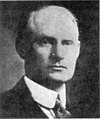Maurice Owen Eldridge

It wasn’t idle flattery when the Engineering News-Record referred to Maurice Owen Eldridge as an “engineer and road expert” in announcing his death on April 28, 1951, at age 77. The announcement further stated Mr. Eldridge, who was called “M.O.” had retired in 1946 after 52 years as a roadbuilder.
“Road expert” was the official title given to key staff members of the Office of Road inquiry in its early days. Few were as well-qualified to hold it as M.O. Eldridge.
He was proficient in many fields: roadbuilding, road research, highway economics, highway finance and taxation, highway safety, promotion of good roads, and program administration. He was a well-known lecturer, an author and editor of reports, articles, and technical papers.
Eldridge was a man of broad vision, strong convictions, great zeal, dedication, and dogged determination. These good qualities sometimes got him into trouble with his superiors, but subsequent events nearly always vindicated him.
His dream of good roads was based on good common sense and sound economics. He not only lived to see it come true, but was an active participant in its fulfillment.
Basically, his dream was that the Federal Government and the States would join together in a cooperative program of road improvement. This dream became a reality with the enactment of the Federal Aid Road Act on July 11, 1916.
Eldridge was an active participant in developing rules and regulations for implementing the new program and in preparing much of the background information which eventually led to the passage of the Federal Highway Act of 1921.
M.O. Eldridge was born July 3, 1873, on a farm near Lenoir, Tenn. Many anecdotes are told about Eldridge, some verifiable, some not.
He went to a log schoolhouse where the seats were made by splitting logs in two and the flat sides were used as seats and backs. His teacher was a Baptist preacher named Pope who believed that, in addition to being taught such classical subjects as Greek and geometry, his students should be taught manual dexterity. He showed them how to make their own compasses and to use poke and other berries from the nearby woods to color designs they had traced. Eldridge’s interest in drawing and drafting got him his first job in 1894 with the Office of Road Inquiry in Washington, D.C.
While attending the University of Tennessee, Eldridge’s talents came to the attention of University President Charles W. Dabney who shortly became the Secretary of Agriculture. The Department of Agriculture was a small organization and when a man was wanted to draw some maps, Secretary Dabney knew the right individual to get and that is how M.O. Eldridge began his roadbuilding career at a princely salary of $60 a month.
Returning to Washington from a trip to Tennessee, M.O. was looking pensively out the train window at the drab, sodden countryside on a rainy November day in 1902, when the train stopped at Jonesboro in eastern Tennessee. He saw an acquaintance, Congressman W. P. Brownlow, board the train. They got into a conversation with another passenger, District Judge Hal Haines, who joined them on the train at Bristol.
The subject of conversation turned to the deplorable condition of the roads; inspiration was the view outside the train windows.
What could be done to improve them? Eldridge pointed out that most rural and small-town residents took such paralyzing road condi- tions for granted, not knowing how to go about improving them. But, said Eldridge, improvement was possible, and, in his opinion, the Federal Government should not only take the initiative in showing the people how to build good roads, it should cooperate with them in doing it.
